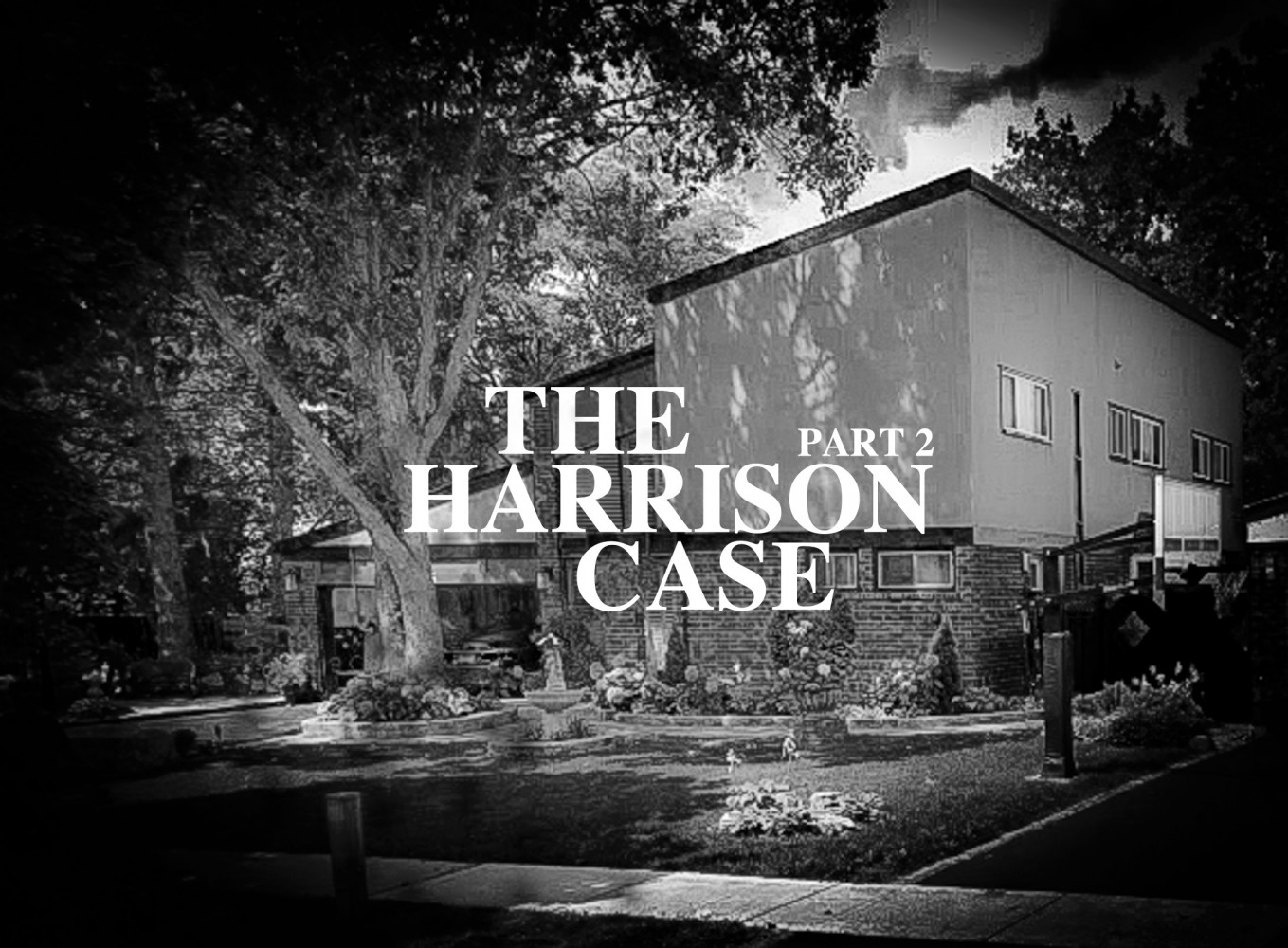
Part 2—The Harrison murders: How did police fail to catch a killer?
The Pointer is republishing this three-part series originally published August of 2020.
Maybe it was the paperboy who first noticed something was wrong.
On at least three occasions prior to April 21, 2010, the person who delivered the Harrison’s newspaper noticed a blue Safari van — similar to that driven by Melissa Merritt and Chris Fattore — was parked near the family’s house. Merritt was the former partner of Caleb Harrison, whose parents owned the home. The pair had been in a fierce dispute for years over custody of their two children.
The sudden appearance of the van was odd. The sleepy Mississauga neighbourhood walked daily by the paperboy seldom changed. It was like Groundhog Day.
But there was no reason to suspect anything malicious was at play.
Until April 21, 2010. A year earlier, inside the home at 3635 Pitch Pine Crescent, Bill Harrison had been found dead.
On this spring day his wife, Bridget, was also found dead, at the foot of the main floor staircase.
There were signs of strangulation and a raft of other clues connecting the two tragedies. But Peel police investigators didn’t see anything out of the ordinary. Once again, just like the year before, in the same house, they chalked up the death to another cause.
There would be no homicide investigation.
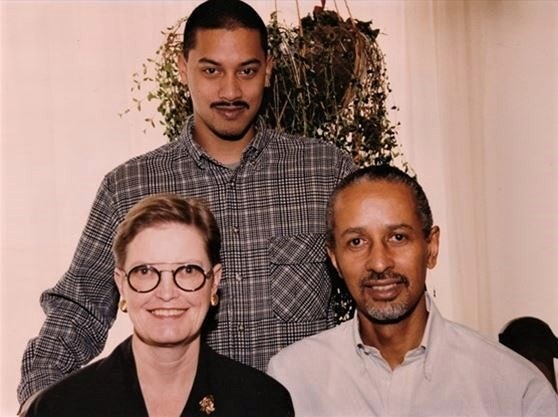
Bridget and Bill Harrison, below, with their son Caleb.
(Facebook)
The 911 call came in from a neighbour’s house. One of Bridget Harrison’s grandchildren returned home from school and found their grandmother laying at the bottom of the stairs, almost directly inside the front door. The eight-year-old knew something was wrong and ran to the neighbours for help.
The first officer who arrived observed the scene: Bridget was laying on her back at the foot of the stairs. The initial conclusion was she fell while coming down. It was the obvious answer. At 4:11 p.m. the constable marked in her notebook: “female, VSA, fell down stairs? (Rigor)”. The word refers to the condition of stiffness that sets into a lifeless body.
When Bridget’s husband Bill was found dead inside the same home, an acute heart arrhythmia was the accepted cause of death. An administrative review of the entire Harrison file released in May by Peel police said the belief among investigators that foul play was not involved in his death, left key pieces of evidence unexamined.
After Bridget’s body was found, the presumption of an accidental death would once again taint the entire investigation, despite clear signs of violence.
A post-mortem coroner’s examination divided her injuries into three categories:
1. Signs of neck compression: There were visible markings that showed something had been wrapped around her neck, including abrasions and bruises below her chin and on her jaw. A dissection revealed bleeding into the muscles of her neck, lower jaw and fractures of the cartilage surrounding her voice box. Petechial hemorrhages — broken blood capillaries often observed in victims of manual strangulation (the use of hands, arms or even legs to choke someone) — were noted on her cheeks, eyelids and covering membranes.
“In combination, these findings are indicative of perimortem compression of the front of the neck,” the post-mortem report reads.
2. Signs of blunt force neck trauma: Bridget’s neck was broken in several places.
3. Signs of blunt trauma: There were also several other injuries to Bridget’s body, including several small rib fractures at the front of the chest on both sides, bruising on her arms and legs.
PART 1 - The Harrison murders: How did Peel Regional Police investigators miss the obvious?
The dilemma for investigators was the evidence stemming from Bridget’s injuries. The petechiae and abrasions on her neck suggested manual strangulation and the need to trigger a full homicide investigation, whereas the broken neck and bruising on other parts of her body could have been caused by a fall down the stairs.
Coroners would not rule out foul play. In an email sent at 7:30 p.m. on the day of Bridget’s death, Peel’s Supervising Coroner Dr. Dirk Huyer (who was appointed Chief Coroner for Ontario in 2014) sent an email to a number of recipients within the Coroner’s Office with the subject line “High Profile Death Case”, noting that it was “potentially criminally suspicious” and he was concerned about “non-accidental trauma.”
Dr. Huyer also made a connection — perhaps inadvertently — that could potentially support a foul play scenario. In a follow-up email sent at 8:49 p.m. that evening to note a smudge on the stair railing as a potential contact point for Bridget’s fall, he also noted “ex-daughter-in-law criminally charged for abduction out on bail with trial tomorrow — police looking for her to get a statement. Looking forward to PM (post-mortem) findings.”
The day after Bridget’s death, she and Caleb were scheduled to be in court to deliver statements in connection to the charges Merritt was facing for abducting her two children the previous year.
The day Bill Harrison was found dead, Merritt and Fattore had fled the province with the two kids. After Bridget, who was still grieving, filed paperwork to launch an investigation under the terms of the custody order for her grandchildren and pressed police to take action, Merritt and Fattore were found in Nova Scotia with the children, six months after Bill’s death had been deemed the result of natural causes.
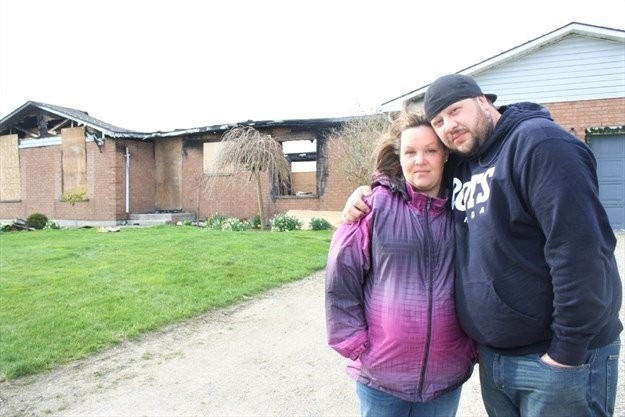
Melissa Merritt and Chris Fattore.
(Facebook)
The evening Bridget’s body was found, while grappling with the death of his mother, Caleb was interviewed by police and questioned about whether he thought anyone had a motive to hurt his mom.
His initial answer: no. The detective wrote this down in a notebook before Caleb changed his answer. “I would ask where Melissa and Chris were personally,” he said.
Early in the morning of April 22, 2010, Det. Kavcic, the supervising Forensic Identification Services officer, briefed the next day’s shift supervisor via email. Kavcic was not ruling out foul play in Bridget’s death, but a prevailing theory among officers was starting to set in.
“Her injuries are not consistent with a fall,” he wrote. As a qualifier, the detective added that based simply on the photos, pathologists thought the marks on her neck might have been caused by her final position “with her neck hyper-extended.”
“We were thinking that she may have been dropped by a medical condition and struck her chin on the stair rail as she went down,” he wrote.
The post-mortem that day was unable to determine a specific cause of death, due to the fact both the neck fractures and the neck compression could have killed Bridget on their own. The cause of death was left as “neck injuries.”
Yet, according to the post-mortem report’s analysis, the evidence was clearly tilted in one direction.
For coroners and pathologists, there are several key injuries they look for when trying to identify victims of strangulation, such as skin injuries on the front of the neck, petechiae, and neck strap muscle hemorrhages. Bridget had them all. The only thing that didn’t fit was multiple fractures in Bridget’s neck and the bruising on other parts of her body. This might have suggested a fall down the stairs. Compared to the evidence against this theory, it’s clear the post-mortem findings pointed to wrongdoing.
Years later, the final tragedy in the Harrison saga would reveal the truth.
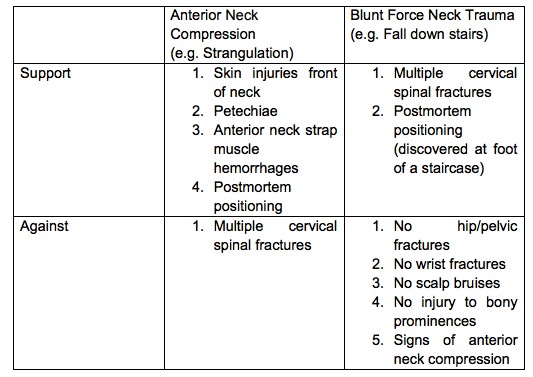
The medical evidence for Bridget Harrison's cause of death.
(Peel Police)
At the start of the workday on April 23, 2010, with the post-mortem report in hand, a group of Peel police investigators reviewed the details of the death. In the report, pathologists and coroners described a “constellation” of injuries consistent with strangulation.
When the meeting concluded less than two hours later, the team revisited the scene. The forensic pathologist took about 15 minutes, and Peel investigators approximately 40 minutes before heading back to the station. In that short time, detectives noted that “all in all, the scene has nothing there to indicate any type of foul play or struggle.”
It was decided that the case would be left in the hands of 11-Division officers with the Homicide Bureau monitoring from the outside for any major developments.
But suspicion that Bridget’s death was not accidental was cast by the medical investigators. Dr. Michael Pollanen, Ontario’s Chief Forensic Pathologist who reviewed the post-mortem report in Toronto, described her injuries as “worrisome,” and even went so far as to suggest suspicion around Bridget’s death also raised questions about what happened to her husband Bill the year before.
His suspicions were so strong, he tried ordering Bill’s body be exhumed for examination. Like Bridget’s death now before him, there was never any anatomical cause of death determined for Bill, either, and there were further unexplained injuries (to his head, neck and the broken sternum) which needed further investigation. Unfortunately, Bill’s body had been cremated shortly after his death.
On April 26, police interviewed the Harrison’s paperboy, learning that on at least three occasions prior to the day of Bridget’s death, he’d noticed a blue Safari van, similar to the one driven by Fattore and Merrit, parked near the home. He never saw anyone inside.
Back at the Coroner’s Office in Toronto, concern was starting to mount about how detectives were angling their investigation. Coroner Dr. Robert Boyko took note of a conversation he had with Pathologist Dr. Michael Pickup, who had shared his concern about the progress of the police investigation which had yet to determine a possible homicide, despite Bridget’s body displaying four out of the five findings consistent with strangulation. This concern was not shared with the Peel Regional Police until June 10, 2010.
Aside from Caleb’s initial suspicion on the night of his mother’s death, finger-pointing was only being directed toward one person — back at him.
Both Merritt and Fattore said Caleb was a violent individual who did not get along with Bridget, and was more than capable of killing her.
During his interview, Fattore unleashed invective against Caleb, sharing a story about how the adopted son had once attacked someone at a grocery store for cutting in front of him and Bill in line.
“Bill had words with him, the guy said something back to Bill, and Caleb went up and put him in a chokehold and choked him out,” Fattore said.
The veracity of the story is not addressed in the internal review.
Caleb, during his own interview days prior, admitted he didn’t always get along with his mother, but said he had nothing to do with her death. When asked if he’d take a polygraph to attest to that fact, he said, “the sooner the better.”
For his own alibi, Fattore said he spent most of the day with Merritt at her home daycare. He attended Sobeys twice during the day (something later confirmed by surveillance footage from the store) as well as running some other small errands. This was later confirmed by Merritt, who was less than cooperative with investigators.
On the same day Fattore was interviewed, police met with Merritt who informed them she was told by a lawyer not to provide a statement to police if she was being investigated as a suspect. Officers told her she was not a suspect, only a family member who could possibly help shed some light on what happened to Bridget.
She said she would consider it.
A few days later, Merritt again refused to provide a statement. Her father, a retired Toronto police detective, was visibly upset with Peel officers, acting “confrontational and demanded to know why police want to speak with his family.”
When she finally did agree to provide a statement on May 5, she confirmed Fattore’s alibi, and said she was at home operating her daycare. She also pointed the finger at Caleb, describing him as a violent individual. By May 13, Merritt would refuse all further interviews.
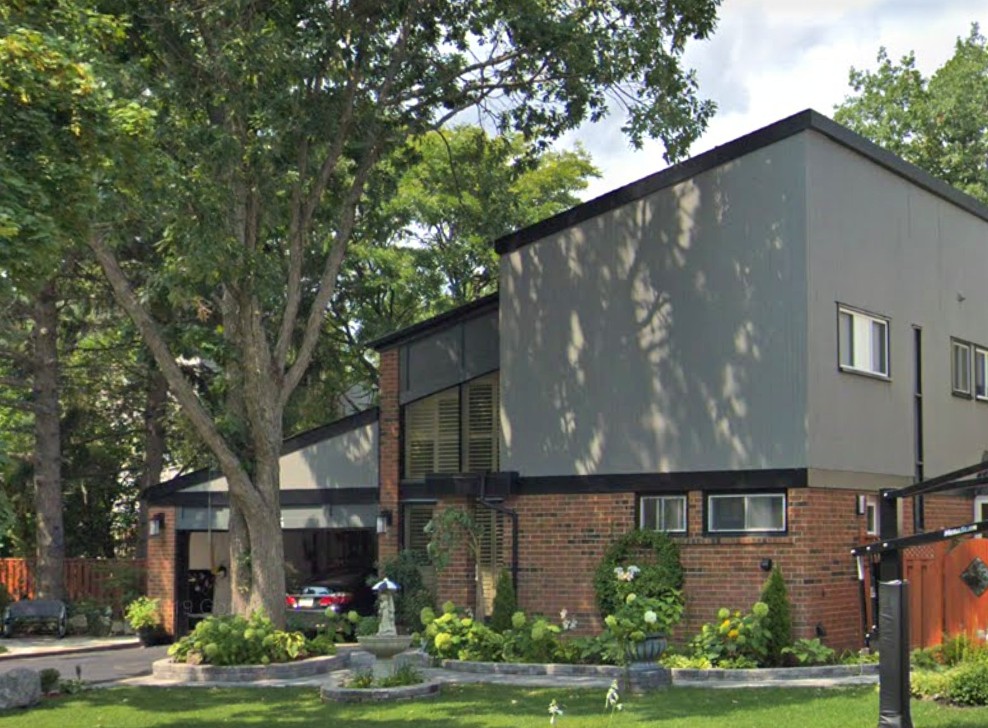
The Mississauga house where the Harrisons lived.
(Joel Wittnebel/The Pointer)
Later that day, investigators planned a detailed case conference scheduled for June 10. It’s unclear why this crucial meeting would be scheduled so long after Bridget’s death. It appears most of their investigative work had concluded, and they determined foul play was not a factor.
“As of this morning, all parties have agreed to the polygraphs and the alibis have been firmed up,” Detective Brennan of Peel’s Homicide Bureau wrote. “We discussed the PowerPoint presentation (for the June 10th meeting) and basically came to an agreement that it will run chronologically from 2009 and outline as methodically as possible the investigative steps taken to rule out any form of ‘foul play’ from our end. It may be lengthy, but will hopefully clarify many of the issues causing concern for the Pathologists.”
Despite the claim that all alibis had been “firmed up”, the very next day officers were still working on trying to confirm parts of Fattore’s story. A meeting with Merritt’s grandmother confirmed Fattore had visited on April 21. Investigators were working to gain approval to search Caleb’s cell phone records.
However, by the end of May, investigative work on the case stalled. After the case conference in early June, any chance of a murder probe into Bridget’s killing was effectively over.
Without an obvious cause of death, the investigation was crippled by a lack of direction. A clear cause of death gives officers a path to follow, and the process often leads to the evidence needed. In shootings there are bullet casings and tracking that can be completed. For blunt force trauma there are splatter patterns, and DNA collection from defensive wounds can generate new leads. Without these sign posts to follow, Peel investigators just spun their wheels.
The coroners and pathologists agreed that the cause of Bridget’s death could not be scientifically determined to be a homicide. While Dr. Pickup’s analysis leaned toward her death being a homicide by strangulation, he would not commit to the theory. The analysis was peer-reviewed by Dr. David Chiasson, an expert in forensic pathology, who came to the same conclusion.
“I agree that the constellation of head and neck findings is difficult to pigeon hole into a mechanistic category,” he wrote “I am however not convinced that the evidence is sufficiently strong as to warrant outright homicide.”
The case fizzled out after that.
Without any major developments in July and August, the investigation was closed on September 2, 2010.
“After an extensive investigation into this matter, there has been no evidence to suggest foul play or any other criminal act,” wrote Constable Boyer in the case file. “The Coroner has concluded that the cause of death in this matter is asphyxia and the mechanism of death is unknown.”
The closure of the investigation was problematic for several reasons.
First, Cst. Boyer hadn't been involved with the investigation for months – last cataloguing hours for the case on April 29. When asked by reviewers, Boyer was actually uncertain who the lead officer on the case was. He wasn’t the only one confused as the case never had a centralized leader, changing hands multiple times. This sowed confusion about who was in charge and what tasks had or had not been completed.

Peel Police headquarters in Mississauga.
(The Pointer file photo)
The Ontario Major Case Manual states a major case manager — someone to stickhandle the complex workings of a criminal investigation — should be assigned in “every threshold major case”. This includes homicides, attempted murders, sexual assaults, human trafficking and missing persons, among others, when foul play is suspected.
A case manager takes on the investigation and is responsible for the “effective governance of the investigation” – the manual states. He or she is accountable for the end results.
It’s unclear why Peel Police failed to assign a case manager in Bridget’s death, which involved a number of variables that needed to be held together in a complex investigative process.
The management of Bridget’s investigative file changed hands on a nearly daily basis as officers left for other cases or responsibilities. The reviewers found a startling lack of certainty among officers involved, not only about who was in charge, but when the investigation concluded, with one officer stating it ended in May and another in June. There was no formal briefing ahead of the case being closed.
“The investigation just ended,” the review states, and it ended without basic police work being conducted.
Peel Regional Police did not even completely confirm Fattore’s alibi on the day of her death.
“As of Wednesday, May 5, 2010, A/Det Amoroso had reported to Det. Brennan that the alibis of all involved parties had been ‘firmed up’. However, Merritt and Fattore’s had only been partially firmed up,” the internal report states. “A Detective Sergeant assigned as the role of Major Case Manager or conducted a detailed peer review may have assisted in identifying this error.”
When Fattore and Merritt were interviewed by investigators they both shared a similar story of spending most of the day at home where Merritt ran a daycare. Both said Fattore left to run some errands and stopped at a relative’s house.
Police obtained video of Fattore at Sobeys on the day in question when he stopped there between 9:39 a.m. and 9:51 a.m. then again between 2:52 p.m. and 2:59 p.m. The relative, Merritt’s grandmother, refused to provide a statement to police, but did say Fattore stopped by on April 21st. There is nothing in the review to indicate investigators went any further to ‘firm up’ Fattore’s whereabouts that day.
The reviewers acknowledged that this was not enough evidence to exclude the pair as suspects, and confusion and mismanagement allowed them to escape proper scrutiny.
“While investigators believed Merritt and Fattore had been excluded as suspects, objectively they were not ruled out,” the review states.
The Office of the Independent Police Review Director, in an external probe, pointed to “reverse tunnel vision” as hindering Peel investigators. Police decided foul play was not a factor in Bridget’s death, and conducted a half-hearted investigation into two individuals, who were eventually brought to justice, but only after the loss of another life.
“The Administrative Review Team found that the focus of the investigation was to confirm and/or rule out foul play as opposed to investigating a possible homicide,” the review states.
It concluded investigators relied too heavily on the findings of the coroner and pathologist to declare Bridget’s death a homicide, as opposed to investigating that possibility themselves. If the medical experts weren’t going to definitively declare a homicide, even though that was a strong suspicion of theirs, a revolving door of police officers found an easy excuse to dismiss foul play.
“In hindsight, the circumstances and post-mortem examination’s findings, which indicated evidence of possible strangulation may have been sufficient cause for the case to be considered a suspected homicide,” the review states.
“At no time does a police officer wish to be involved in an investigation that fails to uncover the truth.”
This mistake was not minor. The failed investigation let a killer remain at large, and allowed him to strike again three years later.
Yes, the Harrison family was doomed, already reduced by two when the husband and wife were found dead in their Mississauga home. Another fatality was in the offing – which would finally expose the murder plot and the culprits – and fully reveal the tragic ineptitude of Peel police’s top investigators.
Email: [email protected]
Twitter: @JoeljWittnebel
COVID-19 is impacting all Canadians. At a time when vital public information is needed by everyone, The Pointer has taken down our paywall on all stories relating to the pandemic and those of public interest to ensure every resident of Brampton and Mississauga has access to the facts. For those who are able, we encourage you to consider a subscription. This will help us report on important public interest issues the community needs to know about now more than ever. You can register for a 30-day free trial HERE. Thereafter, The Pointer will charge $10 a month and you can cancel any time right on the website. Thank you
Submit a correction about this story


